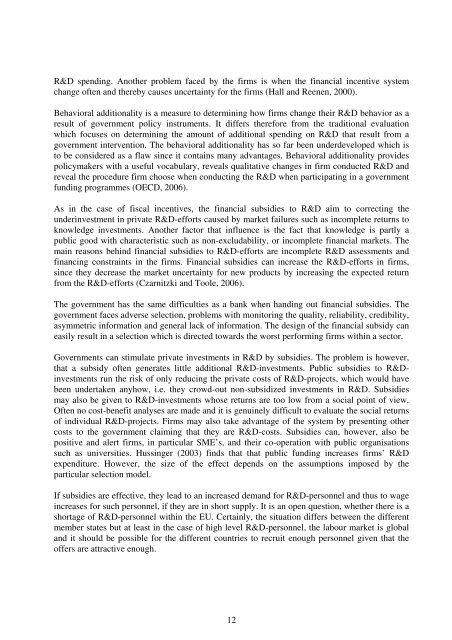INNOVATION POLICY INSTRUMENTS
INNOVATION POLICY INSTRUMENTS
INNOVATION POLICY INSTRUMENTS
You also want an ePaper? Increase the reach of your titles
YUMPU automatically turns print PDFs into web optimized ePapers that Google loves.
R&D spending. Another problem faced by the firms is when the financial incentive system<br />
change often and thereby causes uncertainty for the firms (Hall and Reenen, 2000).<br />
Behavioral additionality is a measure to determining how firms change their R&D behavior as a<br />
result of government policy instruments. It differs therefore from the traditional evaluation<br />
which focuses on determining the amount of additional spending on R&D that result from a<br />
government intervention. The behavioral additionality has so far been underdeveloped which is<br />
to be considered as a flaw since it contains many advantages. Behavioral additionality provides<br />
policymakers with a useful vocabulary, reveals qualitative changes in firm conducted R&D and<br />
reveal the procedure firm choose when conducting the R&D when participating in a government<br />
funding programmes (OECD, 2006).<br />
As in the case of fiscal incentives, the financial subsidies to R&D aim to correcting the<br />
underinvestment in private R&D-efforts caused by market failures such as incomplete returns to<br />
knowledge investments. Another factor that influence is the fact that knowledge is partly a<br />
public good with characteristic such as non-excludability, or incomplete financial markets. The<br />
main reasons behind financial subsidies to R&D-efforts are incomplete R&D assessments and<br />
financing constraints in the firms. Financial subsidies can increase the R&D-efforts in firms,<br />
since they decrease the market uncertainty for new products by increasing the expected return<br />
from the R&D-efforts (Czarnitzki and Toole, 2006).<br />
The government has the same difficulties as a bank when handing out financial subsidies. The<br />
government faces adverse selection, problems with monitoring the quality, reliability, credibility,<br />
asymmetric information and general lack of information. The design of the financial subsidy can<br />
easily result in a selection which is directed towards the worst performing firms within a sector.<br />
Governments can stimulate private investments in R&D by subsidies. The problem is however,<br />
that a subsidy often generates little additional R&D-investments. Public subsidies to R&Dinvestments<br />
run the risk of only reducing the private costs of R&D-projects, which would have<br />
been undertaken anyhow, i.e. they crowd-out non-subsidized investments in R&D. Subsidies<br />
may also be given to R&D-investments whose returns are too low from a social point of view.<br />
Often no cost-benefit analyses are made and it is genuinely difficult to evaluate the social returns<br />
of individual R&D-projects. Firms may also take advantage of the system by presenting other<br />
costs to the government claiming that they are R&D-costs. Subsidies can, however, also be<br />
positive and alert firms, in particular SME’s, and their co-operation with public organisations<br />
such as universities. Hussinger (2003) finds that that public funding increases firms’ R&D<br />
expenditure. However, the size of the effect depends on the assumptions imposed by the<br />
particular selection model.<br />
If subsidies are effective, they lead to an increased demand for R&D-personnel and thus to wage<br />
increases for such personnel, if they are in short supply. It is an open question, whether there is a<br />
shortage of R&D-personnel within the EU. Certainly, the situation differs between the different<br />
member states but at least in the case of high level R&D-personnel, the labour market is global<br />
and it should be possible for the different countries to recruit enough personnel given that the<br />
offers are attractive enough.<br />
12
















